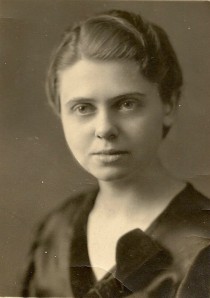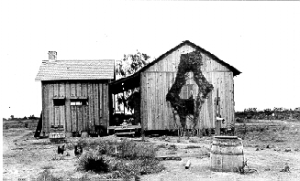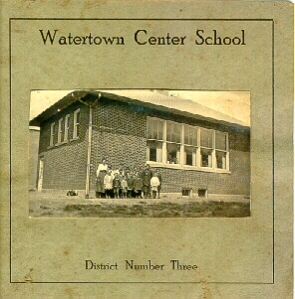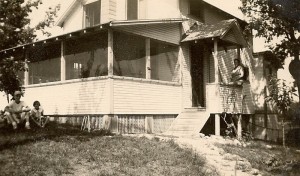
Mary Daniells Winegar
Mary Deone Daniells was born on her parents’ ranch near Mercedes, Texas. Her grandmother, Dora Bliss helped with her delivery. The house in the picture is the house where she was born. Her parents, W.C. and Iva Daniells, were proud of their new glass window that they got before Mary was born. Her middle name is the name of one of her mother’s closest friends, Deone Oppenlander.

House in Mercedes, Texas, where Mary was born.
When she was about six months old, the Daniells family moved to Chicago and, about 18 months later, to Watertown Township near Wacousta. Except for her third grade year, Mary and her sisters attended Watertown Center School until she completed eighth grade. The family spent her third grade year in Tavares, Florida.

This is the school Mary attended. Mary and her two sisters, Dora and Betty, are among the children pictured.
In 1923, the family moved to Eustis, Florida, where Mary graduated from high school. She enrolled in Florida State College for Woman in Tallahassee. Money was scarce during the depression, and she worked in the school lunch room and supplemented her income by darning silk stockings. Her mother assisted by taking in teachers and also repairing stockings. At the end of her junior year, Mary moved back to Michigan to live with her grandparents and completed her last year at Albion College.
Donald Winegar and Mary grew up attending the same church in Wacousta and knew each other slightly. They attended different schools and really had little contact other than at church. In 1928 the Daniells family visited Michigan during the summer. She attended the Epworth League at the church. It was decided that there should be a debate. Nina Winegar, Don’s older sister, and the minister’s son were the negative side, Mary and Don became the affirmative side. Mary doesn’t remember what the topic was, but she remembers that she and Don won. This was the first time that they saw themselves as a couple. They were married 10 years later.

Bass Lake cottage where Mary and Don honeymooned in 1938.
Don and Mary spent their honeymoon at the lake cottage near Greenville, Michigan, built by Orla and Kate Bailey around 1932. Kate Bailey was a cousin of Iva Daniells, Mary’s mother. The Winegar family loved Bass Lake and the cottage so much that 22 years later, Kate insisted that they should have it and arranged an open ended loan that allowed them to pay it off as they were able. Many years later after the death of Mary, her son Jim bought out his brother and sisters and now owns the cottage.

The Winegar family in 1987: left to right, Mary E., Carl, Mary D., Don, Jim, and Donna. This is one of the last pictures made of the entire family.
After their marriage, Mary worked full time as a minister’s wife and a mother of four. They had twin daughters and two sons. They were:
- Donna Lorraine, b. 1939
- Mary Elaine, b. 1939
- James Steven, b. 1944
- Carleton David, b. 1952
After Donald’s death, Mary moved to Bishop’s Glen retirement home in Holly Hill, Florida. She and her sister Eleanor had apartments on the same floor. As Mary’s health declined, Eleanor played a major role in her care. Mary passed away in 2003 in Holly Hill, Florida. Mary and Donald are buried in Wacousta Cemetery. Eleanor Daniells, the last remaining of the five Daniells sisters, died in 2008 and is also buried in Wacousta Cemetery.



 Posted by winegar
Posted by winegar 


 For a number of years, I had had a feeling that I was not yet doing the work which I had been brought into the world to perform. After consulting with some minister friends, I decided to enter the Christian ministry. That decision behind me, I had to secure the necessary educational foundation. A local preacher’s license from my home church at Wacousta was the first step. Admission year work at the Conference Course of Study was the next step.
For a number of years, I had had a feeling that I was not yet doing the work which I had been brought into the world to perform. After consulting with some minister friends, I decided to enter the Christian ministry. That decision behind me, I had to secure the necessary educational foundation. A local preacher’s license from my home church at Wacousta was the first step. Admission year work at the Conference Course of Study was the next step.



















 Nelson’s oldest daughter, Cornelia Hazard writes:
Nelson’s oldest daughter, Cornelia Hazard writes:














